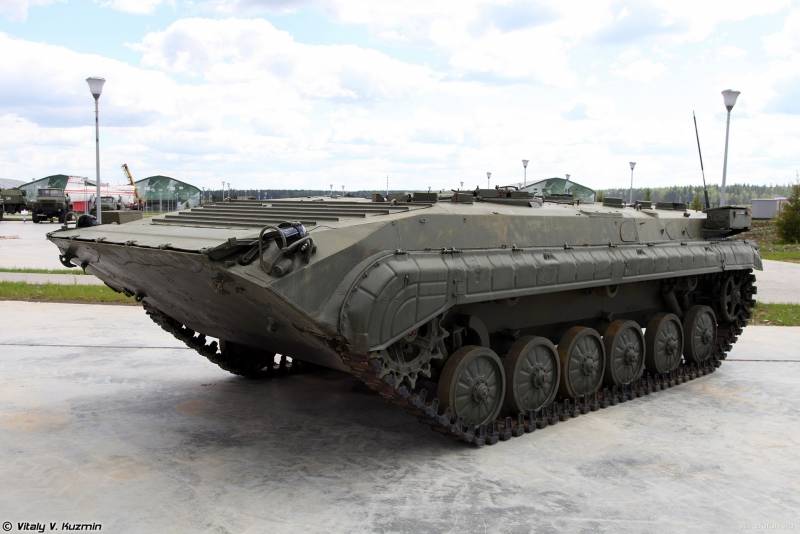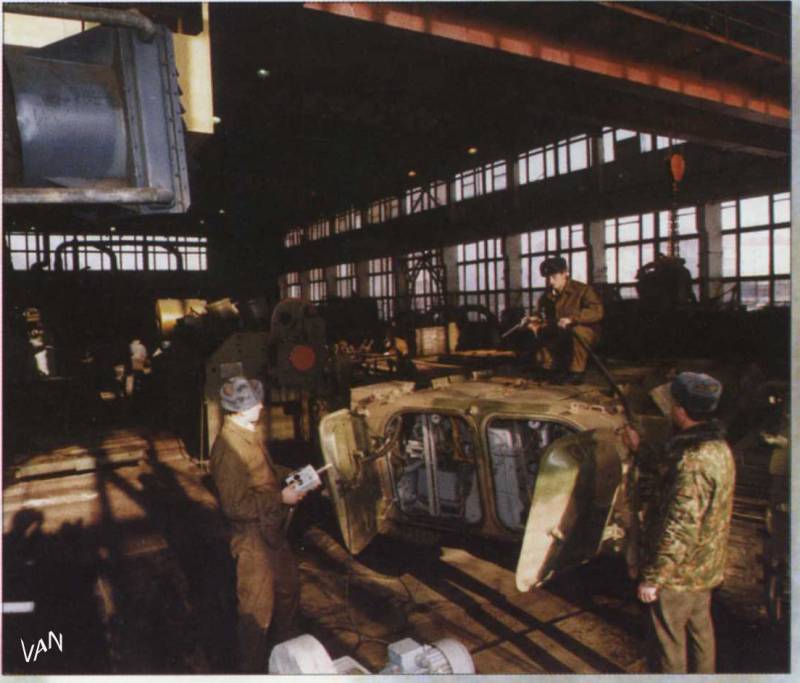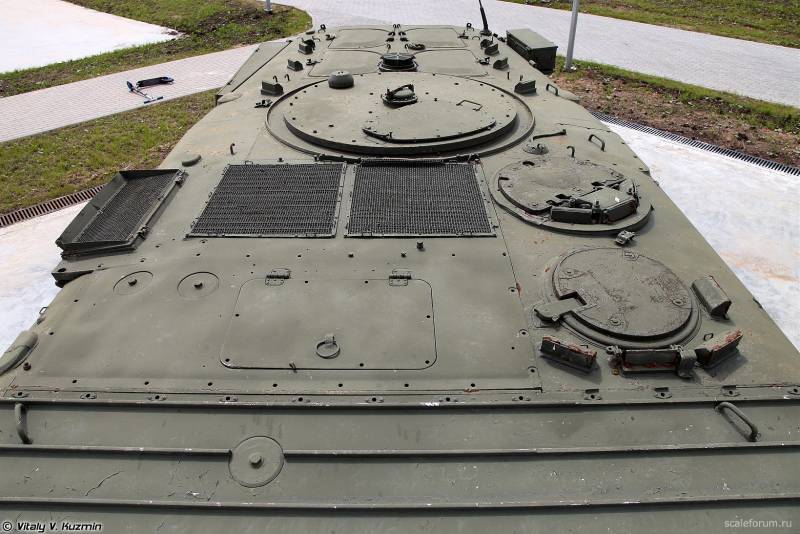From infantry fighting vehicles to fuel trucks. Armored Tanker BTZ-3
Pending a decision
In the thirties in our country there was an attempt to create a tanker based on a tank chassis, but it did not give real results. The development of secure transport for fuel and lubricants actually stopped for several decades. New work in this direction, the result of which was a real model, started in connection with the war in Afghanistan.
Soviet convoys were regularly ambushed by the enemy, who tried to destroy not only combat vehicles, but also support equipment. Fuel tankers were at particular risk and suffered serious losses. In the mid-eighties, this led to the start of research work on the topic of a protected tanker.
However, the matter did not go beyond the preliminary design. Research has shown that the existing losses of tankers are insignificant and can be put up with. In addition, the group in Afghanistan was gradually decreasing, which reduced the need for new technology. As a result, work on protected tankers was stopped for an indefinite period.
After the start of the first war in Chechnya, our army again faced the problem of attacks on convoys, which led to the loss of fuel, equipment and people. The Ministry of Defense has again launched a research project to create a secure tanker. The head contractor in this project was the Design Bureau of Special Engineering (St. Petersburg), headed by A.V. Panteleev.
KBSM worked out a number of options for the appearance of the tanker and presented them to the customer. In the difficult conditions of that time, the army had to choose the simplest project, which involved the restructuring of the BMP-1 infantry fighting vehicle. This project was developed and reached the construction of experimental equipment. The new model was designated as the BTZ-3 armored tanker.
Based on BMP
The BTZ-3 project provided for the restructuring of the existing armored vehicle with the removal of unnecessary units and the installation of new devices. At the same time, it was possible to completely preserve the existing armored hull, powerplant, chassis and some onboard systems. Thus, the level of protection, dimensions and weight, as well as mobility practically did not change. Also managed to maintain buoyancy.
When remaking BMP-1 lost the tower and all the devices of the fighting compartment. Also released the landing squad. The opening under the tower was closed with a round sheet with a hatch for access inside. All hatches and doors of the landing compartment remained in place. Due to this, more convenient access to all on-board transport and distribution equipment was provided.
Most of the vacated volume was occupied by several fuel tanks with a total capacity of 3 thousand liters. There was also a tank for 100 l of oil. Under the tanks used the volume of the former fighting compartment and almost the entire landing compartment. At the same time, aft space remained for the installation of other equipment.
Fuel tanks using a set of pipelines and fittings were assembled into a single system. BTZ-3 received the main and reserve pumping units, as well as a dispensing system with a crane of the PK-32 type. On-board equipment provided the delivery of liquids with a flow rate of up to 150 l / min. A dispensing sleeve with a length of 9 m on a reel was provided. The target equipment compartment was equipped with a fire extinguishing system.
An armored tanker could take on board, transport and issue fuel and lubricants, providing troops. The filling of their tanks was carried out using their own pumps or using external means. The equipment provided refueling equipment, open or closed under pressure. It was also possible to distribute liquids in small containers. The systems were operated in the temperature range from -30 ° to + 30 ° C. It took about 3 minutes to prepare for work or to leave the position.
The BTZ-3 crew included two people responsible for driving and using the target equipment. Their jobs were in the building, in the old department of management. The crew had regular BMP hatches with sight gauges. For communication, the radio station P-123M was used.
The BTZ-3 tanker could move in the same columns with other armored and automotive vehicles of the ground forces and independently overcome water barriers. The crew and liquid cargo were protected from various threats. All-angle protection was preserved from armor-piercing bullets of normal caliber and from small-caliber shells from the front corners.
On the ground and in the army
The design of BTZ-3 was completed in the mid-nineties. The Ministry of Defense allocated two old BMP-1 for the construction of experimental equipment. At one of the repair factories, they were refurbished according to a new project. The resulting experimental technique was to show its capabilities in different conditions.
One of the experienced refuellers underwent comprehensive tests at the landfill. The second prototype was transferred to one of the units involved in Chechnya. Thus, in the shortest possible time, all the necessary checks were carried out, including under the conditions of actual operation in the troops. BTZ-3 has shown all its capabilities and has proven itself well. The car received high marks and could count on a great future.
However, after testing, all work actually stopped. The army did not order serial tankers and introduce them to the troops. Two experienced BTZ-3 were left alone. Now one of these machines is an exhibit in the Patriot Park.
According to various sources, the fate of the project was determined by the financial capabilities of the army and the lack of common views on the need for armored refueling. The use of ready-made chassis did not exclude other construction costs, and the appropriateness of such equipment remained a topic of controversy. As a result, the point of view was won, according to which the BTZ-3 tanker was too expensive and unnecessary for the army.
In the early 2000s, the KBSM attempted to receive orders from civilian structures. The BTZ-3 tanker was offered to enterprises in the oil and gas industry. As far as we know, no commercial organizations were interested in such an offer, and orders were not received. A few years ago BTZ-3 was still present in the KBSM product catalog, but then it was removed.
Advantages and disadvantages
Based on the test results at the training grounds and in the troops, the BTZ-3 armored tanker was highly rated. Indeed, this sample had a number of positive features of a technical and operational nature. However, he was not without some drawbacks.
The main advantage of BTZ-3 could be the fact of the presence of such equipment in the troops. In conditions of armed conflict, a protected refueling tank has obvious advantages over automotive equipment. Such a machine is more likely to survive the enemy attack and save fuel and lubricants for the supplied unit.
Another advantage was the use of an existing and well-developed chassis of the infantry fighting vehicle. This simplified the serial production of new equipment, and also allowed tankers to move in the same columns with motorized gunners, including off-road, through water barriers, etc.
The main disadvantage was the relatively small capacity of the tanks. BTZ-3 transported 3 thousand liters of fuel, and lost tankers by this parameter. So, tankers based on the ZIL-131 truck took at least 4 thousand liters of liquids on board. Other equipment had even more capacious tanks. At the same time, trucks differ from armored vehicles in less complexity and cost of operation.
Booking a BMP-1 corps could not be considered protection against all threats. Heavy shelling weapons into the side projection or anti-tank grenades could hit the BTZ-3 and provoke a fire. In addition, the tanker externally differed from the linear BMP-1, which threatened its safety.
One way or another, with all its advantages and disadvantages, the BTZ-3 armored tanker was not able to get into the troops. An attempt to bring this car to the commercial market was also unsuccessful. The project could not realize its full potential. As a result, we received only an interesting exhibit in the museum, and the army still has to use unprotected tankers on automobile chassis under any conditions. Whether this situation will change in the future is unclear.



Information